- Home
- Countries & Regions
- Africa
- Burkina Faso
- Activities in Burkina Faso
- Regional Integration
Activities in Burkina Faso
Regional Integration
With regards to the sector of regional integration, JICA supports the development of Burkina Faso by improving interconnection with neighboring countries through development of infrastructures and trade facilitation. We envisage making regional integration a growth engine for West Africa. Based on the Master Plan which is elaborated in the project on the Corridor Development for West Africa Growth Ring (WAGRIC), Japan has effectively been supporting the promotion of regional economic integration through development of sub-regional infrastructure and improvement of efficiency for border customs process, in collaboration with West Africa Economic and Monetary Union (WAEMU). JICA will continue to contribute to the economic development of Burkina Faso through regional integration of West Africa.
I. Intervention modalities
In the Regional Integration sector, JICA intervenes mainly through the following modalities:
- Technical Cooperation through implementation of projects with the support of Japanese experts and the Knowledge Co-Creation Program (training courses)
- Financial cooperation through grant aid
- Loan aid from the Official Development Assistance
A. Grant aid project
1. Project for improvement of the South-Eastern bypass in Ouagadougou (grant agreement signed in August 2017)
JICA finances the construction of Tansoba bypass with the aim of connectivity improvement and local industrial activity promotion by developing transport infrastructure in West African countries. The amount of the project is JPY 5.8 billion or CFA 28 billion. It is a grant from the Government of Japan to Burkina Faso. The length of the target section is 6.97 km, and it starts from the end of the east interchange and finishes before the traffic circle of Ouaga 2000 interchange. The Project components are:
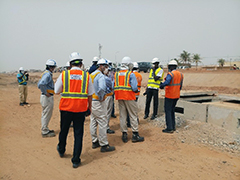 Project for improvement of the South-Eastern bypass in Ouagadougou
Project for improvement of the South-Eastern bypass in Ouagadougou
- Widening of the roadway and creation of a new lane for two - wheeled vehicles
- Renovation and improvement of the roadway surface
- Construction of new sidewalks
- Drainage
- Bus stops
- Street Lighting poles
- Traffic signals
- Pedestrian bridges
B. Loan aid Project
1. Gounghin - Fada - Niger Border Road Improvement Project (loan agreement signed in March 2018)
 Lauching ceremony of the project
Lauching ceremony of the project
On March 2, the Japan International Cooperation Agency (JICA) signed its first JPY 5.659 billion loan agreement with the government of Burkina Faso in Ouagadougou, the capital, for the Gounghin-Fada N'Gourma road improvement project.
The project includes laying pavement and amplification for the Gounghin - Fada N'Gourman section (about 50 km) of National Road No. 4 located on the international corridor (about 218 km) from Gounghin, in the east of Burkina Faso, to Fada. The road was built in 1985 and is currently in a very advanced state of deterioration. This road provides access to three neighboring countries: Niger, Togo and Benin. The objective of the project is to make the transport network more efficient, to contribute to poverty reduction and economic development in the project area, as well as to achieve regional integration of the countries of WAEMU. The project is co-financed by the African Development Bank (AfDB).
Conditions and amount of the loan
| Name of Project | Amount of loan (million yens) |
Annual interest (%) | Loan term (years) |
Grace period (years) |
Conditions of contracting | |
|---|---|---|---|---|---|---|
| Project | Consulting services | |||||
| Gounghin - Fada N'Gourma road improvement project | 5 659 | 0,01 | N/A | 40 | 10 | Generally not related |
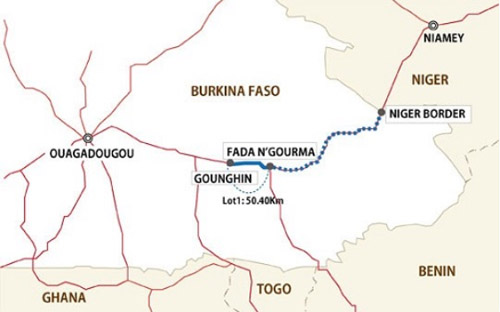 Target site map of the Gounghin - Fada - Niger Border Road Improvement Project
Target site map of the Gounghin - Fada - Niger Border Road Improvement Project
C. Technical Cooperation Project
2. Project for Capacity Development of Road Maintenance Management (PDCER 2021-2024)
Burkina Faso is a landlocked country that shares borders with six neighboring countries: Côte d'Ivoire, Ghana, Togo, Benin, Niger and Mali. Burkina Faso, where WAEMU headquarters is located, plays an important role in the logistical link between these neighboring countries. The strong growth of the Burkina Faso economy in recent years, particularly in terms of exports, has made the maintenance and improvement of the road network a major challenge for the country as well as the surrounding region since 80% of their imports and exports are transported using this road network.
In addition, in the city of Ouagadougou and its suburbs, which are the hubs of the international corridor, the volume of traffic is about 14,000 vehicles per day, and there is such a large number of heavy vehicles that there is a significant impact on the roads. Given the urgent need to establish a maintenance and management system for asphalt roads and improve management techniques, the government of Burkina Faso has requested the government of Japan to implement a technical cooperation project in this area in August 2019.
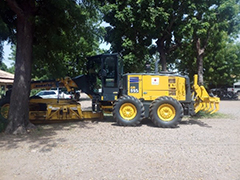 A machine provided by the Japanese embassy in Burkina Faso
A machine provided by the Japanese embassy in Burkina Faso
It is the first project implemented in corporation with the Ministry of Infrastructure of Burkina Faso. Its objective is to set up a road maintenance brigade that will enable emergency road maintenance work to be carried out. It also has a very important component which is the reinforcement of the capacities of the members of the Ministry of Infrastructure who are in charge of road maintenance, and their equipment in road maintenance material. This project will be implemented by Japanese consulting firms and the agents of the Ministry of Infrastructure that are in charge of road maintenance.
III. Completed projects under monitoring
1. Togo-Burkina Customs Interconnection Project
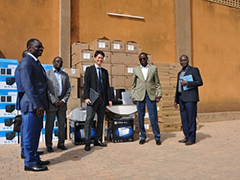 Handover of equipment and materials provided in the Togo-Burkina Customs Interconnection Project
Handover of equipment and materials provided in the Togo-Burkina Customs Interconnection Project
It was the first financial cooperation project implemented with the WAEMU Commission. The objective of this project was to reduce the time required for transit procedures on the Niamey - Lomé and Bamako - Ouagadougou - Lomé corridors through the interconnection of customs computer systems and thus contribute to the smooth transport flow among Togo, Burkina Faso, Niger and Mali. It was also expected that the experiences and know-how gained from this project would be used by other WAEMU member states to improve their customs IT systems. At a cost of USD 1.65 million, this project has provided computer equipment for the customs process of Togo and Burkina. With the technical support of UNCTAD, the interconnection was proved to be effective and officially launched on May 28, 2018, in Ouagadougou.
2. The Project on the Corridor Development for West Africa Growth Ring Master Plan (WAGRIC):
The WAGRIC Master Plan was developed in collaboration with the WAEMU Commission to attract private sector investment and achieve balanced development between coastal areas and landlocked countries.
Master Plan target area: The WAGRIC sub region covers Burkina Faso, Côte d'Ivoire, Ghana, Benin and Togo
Main WAGRIC Target corridors: Five main corridors constituting the growth ring in West Africa: Abidjan-Ouagadougou, Tema-Ouagadougou, Lome-Ouagadougou, Abidjan-Lagos and Cotonou-Ouagadougou
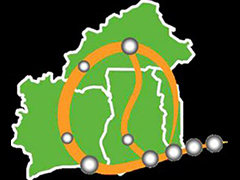
Future Vision for the WAGRIC Sub region: Inclusive and sustainable development will be achieved by developing competitive economic sectors and attracting investment through sub regional economic and spatial integration.
Target years of the Master Plan: 2025 for the short term goals, 2033 for the medium-term goals, and 2040 for the long term goals.
Main strategies and priority projects: A total of 350 priority projects were identified for the implementation of the main strategies according to the selected growth scenario. Simultaneously, implementation plans for individual country were formulated for the development of the corridors which were broken into steps and covered three phases (short-term: 2018-2025, medium-term: 2026-2033 and long-term: 2034-2040). In addition, priority projects in the WAGRIC countries were also formulated.
IV. Technical Assistance
1. Japanese expert assigned to the WAEMU commission
An expert is assigned to the WAEMU Commission as a Technical Advisor to facilitate the formulation and coordination of the Master Plan for the Development of Corridors for the Growth Ring in West Africa (WAGRIC Plan). The JICA Expert being sent to the WAEMU Commission is responsible for assisting the Commission in the implementation of the WAGRIC Master Plan. The expert acts as a Technical Advisor to the Commissioner in charge of the Community Planning and Transport Department (DATC) and the Commissioner in charge of the Regional Market and Cooperation Department (DMRC).

- Asia
- Oceania
- Latin America
- Africa
- Angola
- Benin
- Botswana
- Burkina Faso
- Burundi
- Cameroon
- Comoros
- Côte d'Ivoire
- Democratic Republic of the Congo
- Djibouti
- Eritrea
- Ethiopia
- Gabon
- Ghana
- Kenya
- Liberia
- Madagascar
- Malawi
- Mauritius
- Mozambique
- Namibia
- Niger
- Nigeria
- Rwanda
- Senegal
- Seychelles
- Sierra Leone
- Somalia
- South Africa
- South Sudan
- Sudan
- Tanzania
- Uganda
- Zambia
- Zimbabwe
- Middle East
- Europe
- About JICA
- News & Features
- Countries & Regions
- Our Work
- Thematic Issues
- Types of Assistance
- Partnerships with Other Development Partners
- Climate Change / Environmental and Social Considerations
- Evaluations
- Compliance and Anti-corruption
- Science and Technology Cooperation on Global Issues
- Research
- JICA Development Studies Program / JICA Chair
- Support for the Acceptance of Foreign HRs / Multicultural and Inclusive Community
- Publications
- Investor Relations
